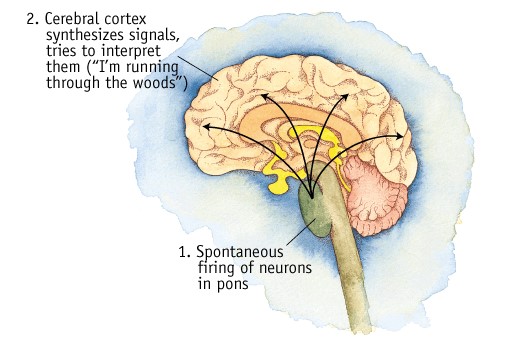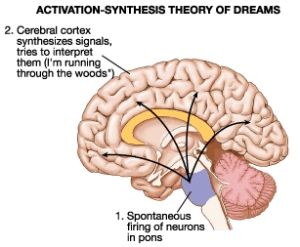Describe the Activation-synthesis Model of Dreaming.
Activation Input-Output and Modulation. It suggests that when we sleep our brain attempts to make sense out whats going on with activity from lower parts like stem and roots as opposed those higher levels where you have greater cognitive functions such thinking skills or memory retention.

Activation Synthesis Theory Of Dreaming Recorded Lecture Sleep And Dreaming Youtube
Some dreams can and do have a deeper meaning with personal significance.

. He used a 3D model called the Activation-Synthesis model of dreaming or AIM model to represent each phase. Psychology Home KNOWLEDGE UNITS. It was first proposed by Harvard University psychiatrists John Allan Hobson and Robert McCarley in 1977.
The AIM model represents the three phases. The query of why individual dreams have perplexed researchers and investigations for 1000 years but it is only generally current in history that researchers have capable to take a near look at specific what takes place in the body and Central nervous system dreaming. This means that even when you are sleeping your brain.
During REM sleep no information enters through the senses. It is a question that scientists philosophers and clergy have attempted to solve for thousands of years. Responses may vary but should include some or all of the following informationThe activation-synthesis model of dreaming says that dreams are a meaningless by-product or epiphenomenon of sleep.
Possible The activation-synthesis model of dreaming says that dreams are a meaningless by-product or epiphenomenon of sleep. Describe the activation-synthesis model of dreaming. The theory claims that during REM sleep the brains neurons are firing in the lower brain centers which send information.
In the activation-synthesis model of dreaming random neural signals from the brain stem are synthesized. Other resources videos. The activation-synthesis theory is a neurobiological explanation for the genesis of dreams first proposed in 1979.
Any article on activation synthesis has to acknowledge that Hobson is the most respected dream researcher in the world. During REM sleep the body is paralyzed. Under this theory dreams are an attempt by the brain to make sense of neural activity which occurs while people sleep.
Online tutorial on theories of dreaming. The theory of dreaming that states that the physiological process of the brain causes dreams. The activation-synthesis model suggests that dreams are caused by the physiological processes of the brain.
During REM sleep neurons are randomly activated. The activation-synthesis model of dreaming says that dreams are a meaningless by-product or epiphenomenon of sleep. Activation-synthesis theory is a neurobiological explanation for the genesis of dreams first proposed in the late 1970s by J.
According to their theory dreams. The activation-synthesis model provides no explanation of how or why this could be the case. The theory claims that during REM sleep the brains neurons are firing in the lower brain centers which send information to.
The activation-synthesis model suggests that dreams are caused by the physiological processes of the brain. While people used to believe that sleeping and dreaming was a passive process researchers now know that the brain is anything but quiet during sleep. The activation-synthesis theory is a physiological or neurobiological explanation of why we dream.
The activation-synthesis theory is a hypothesis related to neurology it describes why we dream. Model of dreaming that believes it is biological dreams are random. Powered by Create your own unique website with customizable templates.
The activation-synthesis model of dreaming says that dreams are a meaningless by-product or epiphenomenon of sleep. He has been working. Allan Hobson and Robert McCarley who say that they result from trying to make sense or synthesize lower brain activities such as.
Allan Hobson and Robert McCarley. Describe the activation-synthesis model of dreaming. This chapter provides the most detailed critical analysis yet developed of the neurophysiological theory of dreaming called activation-synthesis theory a bottom-up theory that rejects a top-down neurocognitive approach because rigorous studies of dream content allegedly cannot be carried out especially on the basis of dream reports collected in the sleep lab.
The theory suggests that dreams are created by changes in neuron activity that activates the brainstem during REM sleep. This model of dreaming is a neurobiological explanation of why we dream and suggests that dreaming results from the brains attempt to make sense of neural activity that takes place during sleep. While people used to believe that sleeping and dreaming was a passive process researchers now know that the brain is anything but quiet during sleep.
Up to 24 cash back Activation Synthesis Theory of Dreaming. The theory claims that during REM sleep the brains neurons are firing in the lower brain centers which send information to the cortex or the part of the brain that makes sense of inputs during normal consciousness. The theory claims that during REM sleep the brains neurons are firing in the lower brain centers which send information to the cortex or the part of the brain that makes sense of inputs during normal.
The Activation Synthesis Dream Theory is an attempt to explain why it is that humans dream. The activation-synthesis theory is a neurobiological explanation for what causes dreams first proposed in the late 1970s by J.

Activation Synthesis Theory 101 The Model Explained

Dreams Dream Facts 25 Of Your Night S Sleep Or 2 Hours Is Spent Dreaming Sleep Thinking Vague Uncreative Bland Thoughts About Real Life Events Ppt Download

Why Do We Dream Siowfa15 Science In Our World Certainty And Controversy

Learn About Theories Of Dreams And Activation Synthesis Model Chegg Com
No comments for "Describe the Activation-synthesis Model of Dreaming."
Post a Comment